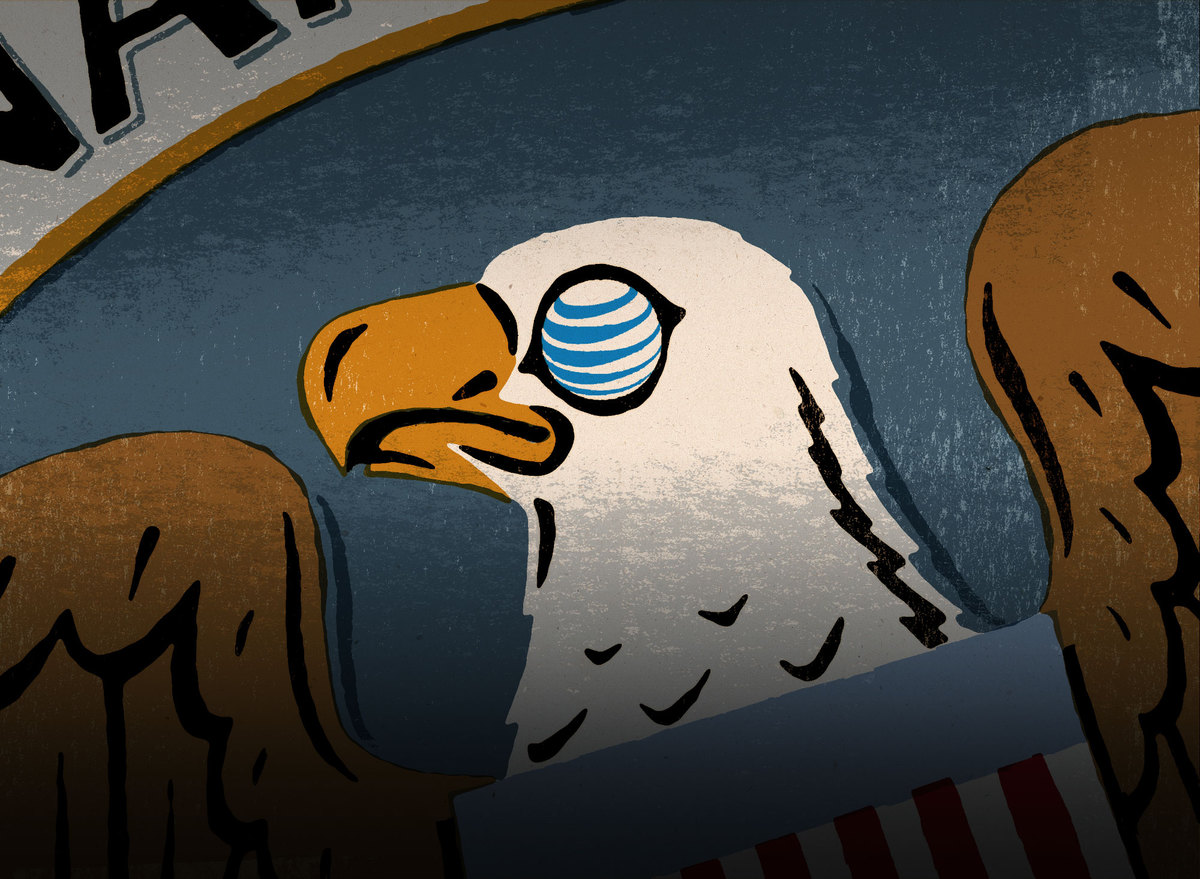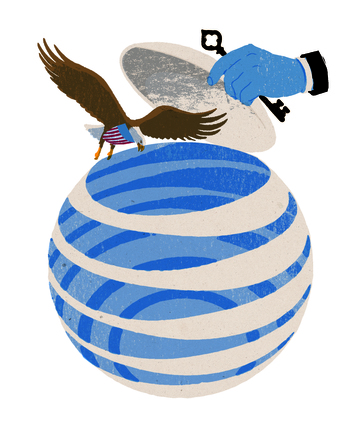NSA Spying Relies on AT&T’s ‘Extreme Willingness to Help’
WHISTLEBLOWING - SURVEILLANCE, 17 Aug 2015
The National Security Agency’s ability to spy on vast quantities of Internet traffic passing through the United States has relied on its extraordinary, decades-long partnership with a single company: the telecom giant AT&T.
15 Aug 2015 – While it has been long known that American telecommunications companies worked closely with the spy agency, newly disclosed N.S.A. documents show that the relationship with AT&T has been considered unique and especially productive. One document described it as “highly collaborative,” while another lauded the company’s “extreme willingness to help.”
AT&T’s cooperation has involved a broad range of classified activities, according to the documents, which date from 2003 to 2013. AT&T has given the N.S.A. access, through several methods covered under different legal rules, to billions of emails as they have flowed across its domestic networks. It provided technical assistance in carrying out a secret court order permitting the wiretapping of all Internet communications at the United Nations headquarters, a customer of AT&T.
The N.S.A.’s top-secret budget in 2013 for the AT&T partnership was more than twice that of the next-largest such program, according to the documents. The company installed surveillance equipment in at least 17 of its Internet hubs on American soil, far more than its similarly sized competitor, Verizon. And its engineers were the first to try out new surveillance technologies invented by the eavesdropping agency.
One document reminds N.S.A. officials to be polite when visiting AT&T facilities, noting, “This is a partnership, not a contractual relationship.”
The documents, provided by the former agency contractor Edward J. Snowden, were jointly reviewed by The New York Times and ProPublica. The N.S.A., AT&T and Verizon declined to discuss the findings from the files. “We don’t comment on matters of national security,” an AT&T spokesman said.
It is not clear if the programs still operate in the same way today. Since the Snowden revelations set off a global debate over surveillance two years ago, some Silicon Valley technology companies have expressed anger at what they characterize as N.S.A. intrusions and have rolled out new encryption to thwart them. The telecommunications companies have been quieter, though Verizon unsuccessfully challenged a court order for bulk phone records in 2014.
At the same time, the government has been fighting in court to keep the identities of its telecom partners hidden. In a recent case, a group of AT&T customers claimed that the N.S.A.’s tapping of the Internet violated the Fourth Amendment protection against unreasonable searches. This year, a federal judge dismissed key portions of the lawsuit after the Obama administration argued that public discussion of its telecom surveillance efforts would reveal state secrets, damaging national security.
The N.S.A. documents do not identify AT&T or other companies by name. Instead, they refer to corporate partnerships run by the agency’s Special Source Operations division using code names. The division is responsible for more than 80 percent of the information the N.S.A. collects, one document states.
Fairview is one of its oldest programs. It began in 1985, the year after antitrust regulators broke up the Ma Bell telephone monopoly and its long-distance division became AT&T Communications. An analysis of the Fairview documents by The Times and ProPublica reveals a constellation of evidence that points to AT&T as that program’s partner. Several former intelligence officials confirmed that finding.
A Fairview fiber-optic cable, damaged in the 2011 earthquake in Japan, was repaired on the same date as a Japanese-American cable operated by AT&T. Fairview documents use technical jargon specific to AT&T. And in 2012, the Fairview program carried out the court order for surveillance on the Internet line, which AT&T provides, serving the United Nations headquarters. (N.S.A. spying on United Nations diplomats has previously been reported, but not the court order or AT&T’s involvement. In October 2013, the United States told the United Nations that it would not monitor its communications.)
The documents also show that another program, code-named Stormbrew, has included Verizon and the former MCI, which Verizon purchased in 2006. One describes a Stormbrew cable landing that is identifiable as one that Verizon operates. Another names a contact person whose LinkedIn profile says he is a longtime Verizon employee with a top-secret clearance.

AT&T’s cable station in Point Arena, California. NSA collection at this site was temporarily disrupted after the 2011 Japanese earthquake damaged the undersea cable. (Henrik Moltke for ProPublica)
After the terrorist attacks of Sept. 11, 2001, AT&T and MCI were instrumental in the Bush administration’s warrantless wiretapping programs, according to a draft report by the N.S.A.’s inspector general. The report, disclosed by Mr. Snowden and previously published by The Guardian, does not identify the companies by name but describes their market share in numbers that correspond to those two businesses, according to Federal Communications Commission reports.
AT&T began turning over emails and phone calls “within days” after the warrantless surveillance began in October 2001, the report indicated. By contrast, the other company did not start until February 2002, the draft report said.
In September 2003, according to the previously undisclosed N.S.A. documents, AT&T was the first partner to turn on a new collection capability that the N.S.A. said amounted to a “ ‘live’ presence on the global net.” In one of its first months of operation, the Fairview program forwarded to the agency 400 billion Internet metadata records — which include who contacted whom and other details, but not what they said — and was “forwarding more than one million emails a day to the keyword selection system” at the agency’s headquarters in Fort Meade, Md. Stormbrew was still gearing up to use the new technology, which appeared to process foreign-to-foreign traffic separate from the post-9/11 program.
In 2011, AT&T began handing over 1.1 billion domestic cellphone calling records a day to the N.S.A. after “a push to get this flow operational prior to the 10th anniversary of 9/11,” according to an internal agency newsletter. This revelation is striking because after Mr. Snowden disclosed the program of collecting the records of Americans’ phone calls, intelligence officials told reporters that, for technical reasons, it consisted mostly of landline phone records.
That year, one slide presentation shows, the N.S.A. spent $188.9 million on the Fairview program, twice the amount spent on Stormbrew, its second-largest corporate program.
After The Times disclosed the Bush administration’s warrantless wiretapping program in December 2005, plaintiffs began trying to sue AT&T and the N.S.A. In a 2006 lawsuit, a retired AT&T technician named Mark Klein claimed that three years earlier, he had seen a secret room in a company building in San Francisco where the N.S.A. had installed equipment.
Mr. Klein claimed that AT&T was providing the N.S.A. with access to Internet traffic that AT&T transmits for other telecom companies. Such cooperative arrangements, known in the industry as “peering,” mean that communications from customers of other companies could end up on AT&T’s network.
After Congress passed a 2008 law legalizing the Bush program and immunizing the telecom companies for their cooperation with it, that lawsuit was thrown out. But the newly disclosed documents show that AT&T has provided access to peering traffic from other companies’ networks.
AT&T’s “corporate relationships provide unique accesses to other telecoms and I.S.P.s,” or Internet service providers, one 2013 N.S.A. document states.
Because of the way the Internet works, intercepting a targeted person’s email requires copying pieces of many other people’s emails, too, and sifting through those pieces. Plaintiffs have been trying without success to get courts to address whether copying and sifting pieces of all those emails violates the Fourth Amendment.
Many privacy advocates have suspected that AT&T was giving the N.S.A. a copy of all Internet data to sift for itself. But one 2012 presentation says the spy agency does not “typically” have “direct access” to telecoms’ hubs. Instead, the telecoms have done the sifting and forwarded messages the government believes it may legally collect.
“Corporate sites are often controlled by the partner, who filters the communications before sending to N.S.A.,” according to the presentation. This system sometimes leads to “delays” when the government sends new instructions, it added.
The companies’ sorting of data has allowed the N.S.A. to bring different surveillance powers to bear. Targeting someone on American soil requires a court order under the Foreign Intelligence Surveillance Act. When a foreigner abroad is communicating with an American, that law permits the government to target that foreigner without a warrant. When foreigners are messaging other foreigners, that law does not apply and the government can collect such emails in bulk without targeting anyone.
AT&T’s provision of foreign-to-foreign traffic has been particularly important to the N.S.A. because large amounts of the world’s Internet communications travel across American cables. AT&T provided access to the contents of transiting email traffic for years before Verizon began doing so in March 2013, the documents show. They say AT&T gave the N.S.A. access to “massive amounts of data,” and by 2013 the program was processing 60 million foreign-to-foreign emails a day.
Because domestic wiretapping laws do not cover foreign-to-foreign emails, the companies have provided them voluntarily, not in response to court orders, intelligence officials said. But it is not clear whether that remains the case after the post-Snowden upheavals.
“We do not voluntarily provide information to any investigating authorities other than if a person’s life is in danger and time is of the essence,” Brad Burns, an AT&T spokesman, said. He declined to elaborate.
***************
Timeline: NSA and AT&T’s Close Relationship through the Years
1984
The “Ma Bell” phone monopoly breaks up into regional “Baby Bells” and a long-distance company that retains the AT&T name and enters the computer business.
1985
NSA launches Fairview program partnership with a single partner, AT&T, according to internal documents.
1985
AT&T’s first big contract as a standalone company is a nearly $1 billion agreement to provide computers and services to the National Security Agency, according to news reports at the time.
2001
In the days after the 9/11 terrorist attacks, Congress passes the Patriot Act. President Geroge W. Bush also secretly authorizes a warrantless wiretapping program known as Stellar Wind. AT&T is the first company to start turning over records under both programs, according to internal documents.
2003
AT&T is forwarding more than 1 million emails per day and 400 million Internet metadata records a month to the NSA, according to internal documents.
2003–2006
For three years, AT&T provides the FBI with illegal ‘sneak peeks’ at the calling records for communities of hundreds of people without legally valid requests for the information, according to congressional testimony by FBI General Counsel Valerie Caproni. Verizon told Congress it did not provide similar community information.
2005
The New York Times reveals President Bush’s warrantless wiretapping program.
2006
Former AT&T engineer Mark Klein publicly reveals in a lawsuit a secret room in AT&T’s San Francisco office that he says siphons traffic to the NSA.
2008
Congress passes the FISA Amendments Act, legalizing portions of warrantless wiretapping and granting legal immunity to AT&T and other telecommunications companyies for their participation in it.
2009
9th Circuit Court of Appeals dismisses the case based on Klein’s allegations, citing the immunity granted to telecommunications companies by Congress.
2011
AT&T starts delivering 1.1 billion of its customers’ cellphone calling records per day to the NSA, under the Patriot Act business records provision, according to internal documents.
2013
Edward Snowden passes journalists a trove of NSA documents that reveal the vast scope of NSA spying.
2015
U.S. District Court for the Northern District of California dismisses key portions of another constitutional challenge to AT&T’s fiber taps, after the government argued that any discussion of its collaborations with telecom companies was a state secret.
*****************
Newly Disclosed N.S.A. Files Detail Partnerships with AT&T and Verizon – Aug 15, 2015
These National Security Agency documents shed new light on the agency’s relationship through the years with American telecommunications companies. They show how the agency’s partnership with AT&T has been particularly important, enabling it to conduct surveillance, under several different legal rules, of international and foreign-to-foreign Internet communications that passed through network hubs on American soil. The documents come from the archive provided by the former intelligence contractor Edward J. Snowden. The files do not identify the firms by name, but instead refer to the Fairview and Stormbrew programs, An analysis by The New York Times and ProPublica found a constellation of evidence that AT&T was the Fairview partner and Verizon was part of the Stormbrew program. The documents range from 2003 to 2013; it is not clear whether the arrangements are the same today.
- Special Source Operations: Corporate Partner Access
- Cyber Threats and Special Source Operations
- Excerpts from the Spy Dictionary
- NSA’s Corporate Portfolio
- One Million Emails a Day From AT&T
- Fairview Defined
- Fairview Data Schematics
- AT&T Confirms “Foreignness” for Stormbrew
NSA’s Special Source Operations Newsletter Excerpts
- Spying on the United Nations
- Billions of AT&T Cellphone Records
- The Cable Break Due to the Japanese Earthquake
- AT&T’s ‘Extreme Willingness to Help’
- AT&T’s ‘Highly Collaborative Nature’
- Verizon’s Cable Station Installs NSA Collection Systems
_____________________________________
This story was co-published with The New York Times.
Julia Angwin is a senior reporter at ProPublica. From 2000 to 2013, she was a reporter at The Wall Street Journal, where she led a privacy investigative team that was a finalist for a Pulitzer Prize in Explanatory Reporting in 2011 and won a Gerald Loeb Award in 2010.
Jeff Larson is the Data Editor at ProPublica. He is a winner of the Livingston Award for the 2011 series Redistricting: How Powerful Interests are Drawing You Out of a Vote.
James Risen is an author, reporter and investigative journalist who has exposed various illegal activities by the US government and who is facing imprisonment for refusing to reveal the identity of one of his sources. In his book, State of War: The Secret History of the CIA and the Bush Administration, Risen cites information from an unnamed intelligence agent about a CIA operation, Operation Merlin, which sought to disrupt Iran’s nuclear program. On 2 June, 2014 the US Supreme Court decided not to intervene. Risen has categorically insisted that he will accept imprisonment before violating the confidentiality of his source.
Laura Poitras is a documentary filmmaker, journalist, and artist. She is currently finishing a trilogy of films about post-9/11 America. The first film on the Iraq war, My Country, My Country, was nominated for an Academy Award. The second film on Guantanamo, The Oath, received the Sundance award for cinematography. She is now editing the final film about NSA mass surveillance. In May 2013, she traveled to Hong Kong with Glenn Greenwald to interview Edward Snowden. She has been reporting on Snowden’s disclosures about the NSA for a variety of news outlets, including The Guardian, Der Spiegel, and The New York Times. She has taught filmmaking at Duke and Yale Universities. Laura is the recipient of a 2012 MacArthur Fellowship, and currently lives in Berlin.
Go to Original – propublica.org
DISCLAIMER: The statements, views and opinions expressed in pieces republished here are solely those of the authors and do not necessarily represent those of TMS. In accordance with title 17 U.S.C. section 107, this material is distributed without profit to those who have expressed a prior interest in receiving the included information for research and educational purposes. TMS has no affiliation whatsoever with the originator of this article nor is TMS endorsed or sponsored by the originator. “GO TO ORIGINAL” links are provided as a convenience to our readers and allow for verification of authenticity. However, as originating pages are often updated by their originating host sites, the versions posted may not match the versions our readers view when clicking the “GO TO ORIGINAL” links. This site contains copyrighted material the use of which has not always been specifically authorized by the copyright owner. We are making such material available in our efforts to advance understanding of environmental, political, human rights, economic, democracy, scientific, and social justice issues, etc. We believe this constitutes a ‘fair use’ of any such copyrighted material as provided for in section 107 of the US Copyright Law. In accordance with Title 17 U.S.C. Section 107, the material on this site is distributed without profit to those who have expressed a prior interest in receiving the included information for research and educational purposes. For more information go to: http://www.law.cornell.edu/uscode/17/107.shtml. If you wish to use copyrighted material from this site for purposes of your own that go beyond ‘fair use’, you must obtain permission from the copyright owner.
Read more
Click here to go to the current weekly digest or pick another article:
WHISTLEBLOWING - SURVEILLANCE:

